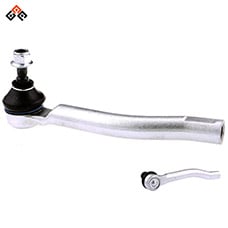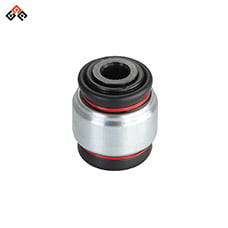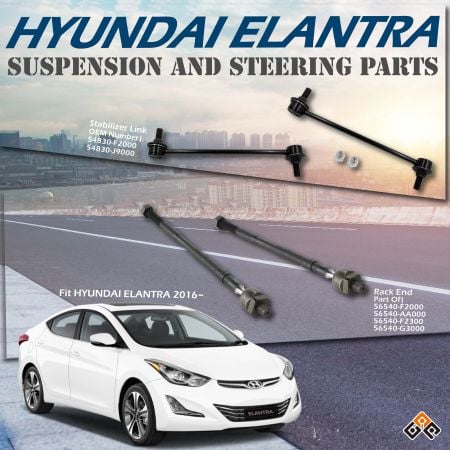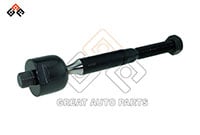Subaru Steering: Role of Quality Tie Rod Ends & Tie Rod End Links
In Subaru steering, it’s all about precision, balance, control. Tie rod ends and tie rod end links do the heavy lifting, keeping every turn smooth and stable, holding your vehicle steady through corners. These parts? They’re essential for handling, they keep your Subaru’s wheels responding accurately to every steering input. Learn how tie rod ends and links work together, why quality matters, and the signs of wear to watch out for. Plus, see the benefits of Great Auto Parts premium tie rod end: durable, rust-resistant, and a perfect fit, made to keep your Subaru driving safe and steady.
What Are Tie Rod End Links and Why Are They Important
Tie rod end links are key parts of your vehicle’s suspension system, responsible for keeping everything steady, controlled, and safe, especially during turns or sudden movements. These links connect the sway bar (also called the stabilizer bar) to the suspension. This connection controls the body roll or lean of the vehicle, ensuring stability. Here’s a quick look at what they do:
- Stabilize the car’s body roll during turns, making for safer, smoother handling.
- Prevent excessive sway when driving over bumps or uneven terrain.
- Maintain alignment between the suspension components, helping with overall vehicle control.
How Do Tie Rod End Links Work Within the Suspension System
Think of the tie rod end link as a connector and stabilizer in one. Attached to the sway bar, it distributes force across the suspension system, keeping the car aligned with the road surface as you drive.
When you make a turn, centrifugal force pulls the car outward, causing the body to lean. Here, the tie rod end link steps in, working with the sway bar to reduce this lean and maintain control. Here’s the breakdown of this process:
| Component | Role in Suspension | Effect During Turns |
| Sway Bar | Links left and right wheels | Distributes force to reduce body roll |
| Tie Rod Link | Connects sway bar to suspension | Stabilizes vehicle and enhances control |
| Tie Rod End | Connects steering to wheels | Guides wheel direction for precise turns |
Together, the sway bar and tie rod end links form a team, distributing forces to keep the car from tipping excessively during turns, making handling more predictable.
How Tie Rod End Links and Tie Rod Ends Work Together for Optimal Steering
Though tie rod end links and tie rod ends serve distinct functions within the suspension and steering systems, they work in harmony to create a balanced, responsive driving experience. Here’s how they contribute to smooth handling, stability, and precision.
| Aspect | Tie Rod End Links | Tie Rod Ends | Combined Effect |
| Primary Role | Part of the suspension system, connects sway bar to suspension, controls body roll during turns. | Part of the steering system, connects steering rack to wheels, transfers driver’s steering input to wheels. | Creates balanced handling by stabilizing vehicle body and ensuring precise wheel alignment. |
| Balance and Alignment | Stabilizes vehicle’s body to prevent excessive leaning, maintaining stability during turns. | Controls wheel direction, keeping vehicle alignment and preventing it from pulling to one side. | Keeps vehicle aligned, prevents wobbling, and ensures stability in turns and straight driving. |
| Steering Responsiveness | Minimizes body movement, providing stability during sharp or sudden maneuvers. | Directly translates steering wheel movement to wheels, allowing accurate response to driver input. | Enhances steering responsiveness and stability, giving the driver better control over handling. |
| Handling Across Conditions | Adapts to rough roads or tight turns by stabilizing suspension and reducing body roll. | Maintains precise wheel direction, aiding control on all surfaces and at varying speeds. | Provides controlled handling on different terrains, improving the overall driving experience. |
| Safety Contribution | Keeps vehicle steady, preventing excessive roll that could lead to instability. | Ensures accurate wheel response to steering inputs, critical for safe maneuvering. | Works together to ensure the driver can maintain control, even in challenging driving conditions. |
| Tire Wear and Vehicle Longevity | Stabilizes body, reducing strain on suspension components and helping prevent uneven tire wear. | Maintains alignment, preventing uneven tire wear caused by misaligned wheels. | Extends tire life and reduces suspension wear, supporting long-term vehicle performance. |
Tie Rod End Link vs. Tie Rod End: What’s the Difference
Although the terms sound similar, tie rod end links and tie rod endshave distinct roles within a vehicle’s suspension and steering systems. Each component contributes differently to vehicle handling, alignment, and stability.
| Feature | Tie Rod End Link | Tie Rod End |
| System Association | Part of the suspension system, connects the sway bar to the suspension to control body roll in turns. | Part of the steering system, connects the steering rack to the knuckle, translating steering input. |
| Primary Function | Controls body stability by reducing roll during cornering, keeping the vehicle level. | Directs wheel alignment based on steering input, allowing precise control of wheel direction. |
| Design and Structure | Metal rod with bushings at each end, absorbing impacts to maintain a firm connection. | Ball joint structure that provides flexibility, ensuring smooth connection with the steering mechanism. |
| Signs of Wear | Clunking sounds during turns or bumps, increased body roll, poor handling. | Looseness or play in the steering wheel, vibrations, difficulty in maintaining straight-line alignment. |
| Driving Experience Impact | Supports stable handling, helping to balance the vehicle’s body, contributing to a smoother ride. | Critical to steering accuracy; affects safety and control if worn or damaged. |
| Replacement Considerations | Replaced when body roll or clunking sounds increase; typical lifespan depends on road conditions. | Requires professional alignment after replacement; regular inspection recommended due to steering role. |
| Material Composition | High-strength steel or alloy, often corrosion-resistant to handle environmental exposure. | Hardened steel with a rubber boot around the ball joint, protecting against contaminants. |
How Tie Rod End Links Work in Different Types of Vehicles
The role of a tie rod end link is essential across vehicle types, but its design and performance demands can vary significantly depending on the specific vehicle:
-
Passenger Cars
In passenger cars, tie rod end links are designed to manage typical road conditions, offering stability during daily driving. They keep the vehicle steady during turns and limit body roll on smooth, paved roads. These links are usually smaller and less heavy-duty, as passenger cars don’t require the same level of reinforcement as off-road vehicles. -
SUVs and Trucks
SUVs and trucks rely on larger, stronger tie rod end links due to their higher center of gravity and greater weight. The links in these vehicles are engineered to withstand the forces associated with carrying heavy loads and performing on both city roads and rougher terrains. These reinforced links ensure that SUVs and trucks maintain proper alignment and handling, even when faced with challenging road conditions. -
Off-Road Vehicles
Off-road vehicles require tie rod end links built for extreme durability. These links are made to withstand impacts from rocks, dirt, and other elements encountered on unpaved trails. Off-road tie rod end links are often constructed from robust materials that resist bending or breaking, which keeps the vehicle steady and balanced across rugged terrain. They also accommodate a wider range of motion for lifted suspensions, enhancing the vehicle’s ability to traverse steep slopes or uneven paths. -
High-Performance or Sports Cars
In high-performance and sports cars, tie rod end links prioritize precision and control at higher speeds. These vehicles use lightweight but resilient materials, allowing for tight, responsive handling. The tie rod end links in sports cars play a key role in minimizing body roll, helping the car maintain grip on the road during sharp turns and quick maneuvers.
Why Do Tie Rod End Links Wear Out Over Time
Tie rod end links are essential for stable handling, yet they face constant stress and exposure that leads to gradual wear. Here are the main factors contributing to their wear:
- Mechanical Stress
Each turn and every bump places strain on tie rod end links, causing stress fatigue over time. Repeated movements create small cracks or weaknesses, weakening the link and reducing its effectiveness. - Driving Conditions
Rough roads, gravel paths, and potholes all increase the impact on tie rod end links, which accelerates wear. In vehicles frequently used for off-road driving or exposed to frequent impacts, end links often experience faster deterioration. - Environmental Exposure
Tie rod end links are exposed to rain, road salt, and moisture, which can lead to corrosion. In regions with heavy salt use during winter, corrosion builds up over time, compromising the link’s durability. - Temperature Changes
Extreme temperature swings, especially from freezing to thawing, affect the materials in tie rod end links. Metal and rubber expand and contract with temperature changes, gradually leading to cracks or brittleness in the link and its bushings. - Quality and Material of Components
Lower-quality materials are more susceptible to stress and environmental factors. High-grade metals and well-treated materials resist wear better, but all links have a limited lifespan. - Aging of Bushings
Bushings, often made of rubber or synthetic materials, degrade over time. As bushings become brittle or crack, they lose their ability to cushion and secure the link, leading to looseness or excessive movement. - Impact Damage
Sudden impacts, such as hitting curbs or potholes, can bend or crack tie rod end links. Even a single impact may significantly damage the link, especially in rough driving environments. - Driving Habits
Aggressive driving habits, including sharp turns or high-speed cornering, place higher loads on tie rod end links. Drivers who push their vehicles to perform at high levels tend to experience faster wear on these components.
Regular inspection and mindful driving can help extend the life of tie rod end links, but wear is inevitable with prolonged use and exposure.
Common Symptoms of a Worn Tie Rod End Link
How can you tell when a tie rod end link is starting to wear out? Here are some signs to watch for:
- Clunking or rattling sounds: If you hear noises when turning or going over bumps, it’s likely a sign of looseness.
- Excessive body roll: More noticeable swaying during turns indicates weakened or loose links.
- Poor handling: If the car feels less stable than before, or you notice less control, check the end links.
These symptoms typically start small but worsen over time, so catching them early can make a difference in driving safety.
How to Inspect and Test Your Tie Rod End Links for Wear
Testing tie rod end links doesn’t require advanced tools. Here’s how you can inspect them:
- Visual Check: Look for rust, corrosion, or signs of looseness.
- Push and Pull Test: If accessible, try gently moving the end link; it should be firm, not wobbly.
- Driving Feel: If your vehicle sways more than usual or if you hear clunking sounds, it’s time for a closer look.
While a simple inspection can reveal issues, a professional check is always recommended if you suspect serious wear or looseness.
Maintenance Tips for Prolonging the Life of Your Tie Rod End Links
keep your tie rod end links in top shape:
- Avoid harsh driving conditions: Reduce driving over potholes or unpaved roads when possible.
- Clean off road salt: If you drive in areas with road salt, clean your undercarriage to prevent corrosion.
- Regularly check: Have your suspension and steering systems inspected periodically, especially if you notice any handling changes or unusual sounds.
Following these steps will help prevent premature wear, helping you avoid unexpected repairs and keeping your vehicle stable on the road.
The Importance of Choosing Great Auto Parts Tie Rod Ends for Your Subaru
When it comes to steering precision and safety, our tie rod ends go above and beyond the standard. While tie rod end links keep your vehicle’s body stable, it’s the tie rod ends that control each turn with pinpoint accuracy. We’ve designed our tie rod ends to provide the highest performance, ensuring your steering feels smooth and responsive for every mile on the road. Here’s why our tie rod ends are the premium choice for lasting quality and unmatched performance:
Key Features and Advantages
- Built Tough: Made with cold or hot forged high-strength steel for maximum durability under stress.
- Rust-Resistant: Advanced surface treatment provides top-tier anti-rust protection, extending product life.
- Traceable Quality: Laser-etched batch codes offer complete traceability and quality assurance.
- OE-Grade Strength: Meets or exceeds OE standards for push and pull strength, ensuring reliable performance.
- Perfect Fit: Direct OE replacement design guarantees a seamless, hassle-free fit.
- Flexible Orders: Small quantities accepted, with a minimum order as low as 30 pieces.
Investing in our quality tie rod ends means investing in your Subaru’s control, safety, and performance. By choosing our tie rod ends, you’re not just ensuring smooth steering,you’re also contributing to the longevity of other crucial components, including your tie rod end links. For ultimate control, reliability, and peace of mind on the road, our premium tie rod ends are the best choice for keeping your Subaru steady, responsive, and safe.






